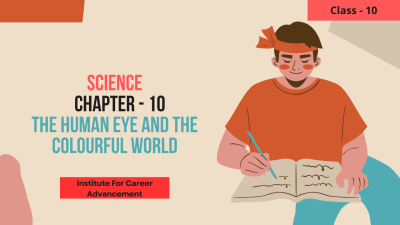The Human Eye and The Colourful World - Class 10
The human eye is one of the most valuable and sensitive sense organs, which enable us to see the colourful world around us. It is just like a photographic camera. The lens system of the eye forms an image of the object on a light sensitive screen. The Human Eye STRUCTURE OF HUMAN EYE: The human eye has the following parts : Cornea : It is the transparent spherical membrane covering the front of the eye. Iris : It is the coloured diaphragm between the cornea and lens. Pupil : It is the small hole in the iris. Eye lens : it is a transparent lens made of jelly like material. Ciliary muscles : These muscles hold the lens in positions. Retina : It is the back surface of the eye. Blind spot : It is the point at which the optic nerve leaves the eye. An image formed at this point is not sent to the brain. Aqueous humor : It is clear liquid region between the cornea and the lens. Vitreous humor : The space between eye lens and retina is filled with another liquid called vitreous humor.In the eye, the image is formed on the retina by successive refractions at the cornera, the aqueous humor, the lens and the vitreous humor. Electrical signals then travel along the optic nerve to the brain to be interpreted. In good light, the yellow spot is most sensitive to detail and the image is automatically formed there. মানুষের চোখ হল সবচেয়ে মূল্যবান এবং সংবেদনশীল ইন্দ্রিয় অঙ্গগুলির মধ্যে একটি, যা আমাদের চারপাশের রঙিন বিশ্বকে দেখতে সক্ষম করে। এটি ঠিক একটি ফটোগ্রাফিক ক্যামেরার মতো। চোখের লেন্স ব্যবস্থা একটি হালকা সংবেদনশীল পর্দায় বস্তুর একটি চিত্র তৈরি করে। মানুষের চোখ মানুষের চোখের গঠনঃ মানুষের চোখের নিম্নলিখিত অংশগুলি রয়েছেঃ কর্নিয়াঃ এটি চোখের সামনের অংশকে আচ্ছাদনকারী স্বচ্ছ গোলাকার ঝিল্লি। আইরিসঃ এটি কর্নিয়া এবং লেন্সের মধ্যবর্তী রঙিন ডায়াফ্রাম। ছাত্রঃ এটি আইরিসের ছোট গর্ত। চোখের লেন্সঃ এটি জেলির মতো উপাদান দিয়ে তৈরি একটি স্বচ্ছ লেন্স। সিলিয়ারি পেশীঃ এই পেশীগুলি লেন্সকে অবস্থানে ধরে রাখে। রেটিনাঃ এটি চোখের পিছনের পৃষ্ঠ। ব্লাইন্ড স্পটঃ এটি সেই বিন্দু যেখানে অপটিক স্নায়ু চোখ ছেড়ে যায়। এই মুহুর্তে গঠিত একটি চিত্র মস্তিষ্কে পাঠানো হয় না। জলীয় রসঃ এটি কর্নিয়া এবং লেন্সের মধ্যে পরিষ্কার তরল অঞ্চল। ভিট্রিয়াস হিউমারঃ চোখের লেন্স এবং রেটিনার মধ্যবর্তী স্থানটি ভিট্রিয়াস হিউমার নামে আরেকটি তরল দিয়ে ভরা হয়।চোখের মধ্যে, কর্নেরা, জলীয় হাস্যরস, লেন্স এবং কাঁচের হাস্যরসের ধারাবাহিক প্রতিসরণের মাধ্যমে রেটিনার উপর চিত্রটি তৈরি হয়। বৈদ্যুতিক সংকেতগুলি তখন অপটিক স্নায়ু বরাবর মস্তিষ্কে ব্যাখ্যা করার জন্য ভ্রমণ করে। ভাল আলোতে, হলুদ দাগটি বিশদ বিবরণের প্রতি সবচেয়ে সংবেদনশীল এবং সেখানে চিত্রটি স্বয়ংক্রিয়ভাবে গঠিত হয়।
English
Last updated
Wed, 27-Nov-2024



















